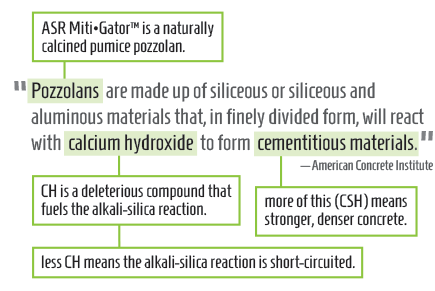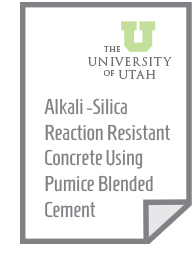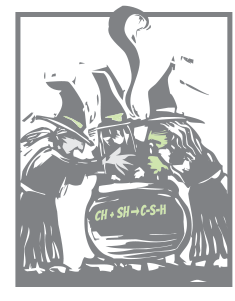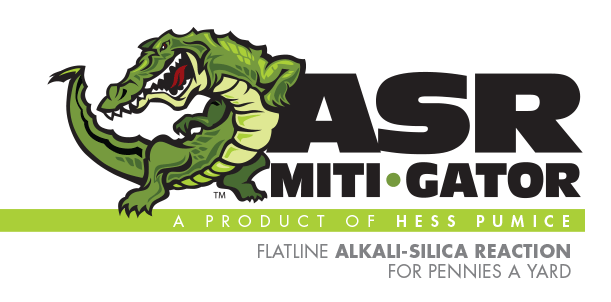About ASR Miti•Gator™
THE RESEARCH | PERFORMANCE BENEFITS BEYOND ASR MITIGATION | THE COMPANY BEHIND ASR MITI•GATOR™ | DOWNLOADS
Executive Summary
ASR Miti•Gator™ is a simple product: carefully refined pumice mined from the world’s purest commercial deposit of white pumice, crushed and processed to a D325 grade. ASR Miti•Gator’s™ complex chemical nature—that which powers the chemical reaction that flatlines the alkali-silica reaction—was engineered by Mother Nature. Pumice is the product of volcanic eruption (naturally calcined), and the effective purity of ASR Miti•Gator, in particular, is the result of eons of wave action upon our source pumice deposit from a vast, ancient (now extinct) freshwater lake.
When ASR Miti•Gator is present in a concrete mix design (at up to 20% replacement of Portland cement, depending on reactivity of the aggregate), it ignites a secondary (pozzolanic) reaction that consumes and mitigates the alkali-silica reaction that occurs when water, Portland cement and reactive (siliceous) aggregate meet.
 Because ASR Miti•Gator™ is not a waste by-product of an industrial process (as are fly ash, furnace slag or silica fume), it performs as a supplementary cementitious material (SCM) consistently and predictably pour after pour after pour. Our performance claims are backed and quantified by current university-level ASTM-spec research and by empirical historic evidence—a couple of millennia worth.
Because ASR Miti•Gator™ is not a waste by-product of an industrial process (as are fly ash, furnace slag or silica fume), it performs as a supplementary cementitious material (SCM) consistently and predictably pour after pour after pour. Our performance claims are backed and quantified by current university-level ASTM-spec research and by empirical historic evidence—a couple of millennia worth.
ASR Miti•Gator™ is sustainable and green: our pumice deposit has a massive confirmed yield, and the mining and refining process is energy-sipping.
The initial cost of specifying ASR Miti•Gator™ is sweetened by the fact that it is used as a percentage of replacement for Portland cement. Of course, the long-term cost benefits of mitigating ASR are the huge—attaining the full engineered life-span of the concrete structure instead of an expensive death-march of stop-gap repairs, demolition, and replacement.
As detailed below, the performance benefits of using natural pumice in a concrete mix design go well beyond defeating ASR. Heat of hydration is reduced and compressive strength preserved. The pozzolanic reaction densely welds the concrete matrix, significantly amping resistance to sulfate and chloride attacks (per ASTM C1012) while increasing abrasion resistance and resisting freeze-thaw damage.
Free of the threat of ASR destruction and with a significant boost in durability via pozzolanic strength and density enhancement, modern concrete structures can finally rival the enduring structures of the old-world Roman empire builders.
The Research
 Beginning in 2012, the University of Utah began research into the effectiveness of pumice as an supplementary cementitious material (SCM) to improve the problematic long-term performance of modern concrete. The durability of Roman concrete provided empirical evidence that pumice (the original pozzolan) was an excellent concrete performance booster, but quantifiable research data was needed.
Beginning in 2012, the University of Utah began research into the effectiveness of pumice as an supplementary cementitious material (SCM) to improve the problematic long-term performance of modern concrete. The durability of Roman concrete provided empirical evidence that pumice (the original pozzolan) was an excellent concrete performance booster, but quantifiable research data was needed.
The results of that study not only quantified the performance of naturally occurring pumice as an effective SCM, but revealed that pumice (in particular the pumice mined and processed in Southeast Idaho from the Hess Pumice deposit) was an impressive mitigator of the alkali-silica reaction. This in turn led to follow-up research into the mechanisms and potency of pumice as a cost-effective ASR-mitigating SCM.
Further detail about the research conducted by the University of Utah (and others) is found on this page—Introduction to Research: Pumice as ASR-Reducing SCM.
Concrete Improvement Benefits Go Beyond ASR Mitigation
ASR Miti•Gator™ is nothing more nor less than an excellent pozzolan—a natural, concrete-improving SCM that also happens to be very, very good at defusing the alkali-silica reaction in modern concrete when reactive aggregate is present.
 THE SUPER-CHARGING POZZOLANIC REACTION: One way to understand the pozzolanic reaction is to think of it as a sort of molecular reclamation project initiated as a secondary reaction within curing concrete, improving and super-charging the primary Portland cement+water reaction.
THE SUPER-CHARGING POZZOLANIC REACTION: One way to understand the pozzolanic reaction is to think of it as a sort of molecular reclamation project initiated as a secondary reaction within curing concrete, improving and super-charging the primary Portland cement+water reaction.
 The initial chemical hydration reaction creates the binding glue (Calcium Silica Hydrate or CSH) that makes concrete concrete. Unfortunately, the primary hydration reaction in modern concrete falls short of its performance potential, producing only about 75% of the CSH that is possible. And, to make matters worse, the Portland cement+water hydration reaction also spawns a deleterious chemical compound: Calcium Hydroxide (CH). This CH does nothing to contribute to the strength and density of the concrete, and it actively works against it—not only factoring into the ignition of ASR in the presance of reactive aggregate, but CH also leaves the cured concrete riven with a network of microscopic worm holes that allow ingress of water and concrete-destroying chemicals like chlorides and sulfates. A secondary pozzolanic reaction is needed to improve and complete the chemical cure (and short-circuit ASR). This is done by replacing a portion of the Portland cement with the pozzolan, and that means the savings from using less OPC offsets much of the cost of the pozzolan8. Win win.
The initial chemical hydration reaction creates the binding glue (Calcium Silica Hydrate or CSH) that makes concrete concrete. Unfortunately, the primary hydration reaction in modern concrete falls short of its performance potential, producing only about 75% of the CSH that is possible. And, to make matters worse, the Portland cement+water hydration reaction also spawns a deleterious chemical compound: Calcium Hydroxide (CH). This CH does nothing to contribute to the strength and density of the concrete, and it actively works against it—not only factoring into the ignition of ASR in the presance of reactive aggregate, but CH also leaves the cured concrete riven with a network of microscopic worm holes that allow ingress of water and concrete-destroying chemicals like chlorides and sulfates. A secondary pozzolanic reaction is needed to improve and complete the chemical cure (and short-circuit ASR). This is done by replacing a portion of the Portland cement with the pozzolan, and that means the savings from using less OPC offsets much of the cost of the pozzolan8. Win win.
SEE ALSO: 8 Whitepaper: How Pumice Pozzolans Super-Charge Concrete Performance (PDF)
Pumice and Concrete: A Brief History
The evidence is empirical: Roman concrete, placed some two millennia ago, is amazingly durable stuff. The same cannot be said about our modern Portland cement concretes. But thanks to on-going research efforts into quantifying how and why pumice super-charges concrete durability, we're finally breaking the chemical code of Roman concrete.
The Romans did not have a quick setting cement like we do today. They used hydrated lime—a cementitious product made from limestone which was heated to drive off the carbon dioxide and transform the Calcium Carbonate into Calcium Oxide (lime) + H2O. Lime does not act like a hydraulic cement on its own, and will only form Calcium Silicate Hydrate (CSH) in the presence of water and a pozzolanic catalyst: in the case of Roman concrete, they used a fine-grained pumice for that catalyst.
 The Romans benefited from this chemistry: when lime and water are mixed with a finely graded amorphous silica (known to the Romans as pulvis puteolanus, and referred to today as volcanic ash or pumice pozzolan) nearly 100% of the lime is converted to cementitious binder—CSH—albeit at a slower rate than modern cements. The hydrated lime combined with pumice to form CSH without creating any additional deleterious by-products. Thus, Roman methods produced a densified, practically impermeable concrete that was not nearly as susceptible to chemical attack as is modern standard concrete. And with this concrete (and mortar) they built their empire of piers, aqueducts, roads, and awe-inspiring structures.
The Romans benefited from this chemistry: when lime and water are mixed with a finely graded amorphous silica (known to the Romans as pulvis puteolanus, and referred to today as volcanic ash or pumice pozzolan) nearly 100% of the lime is converted to cementitious binder—CSH—albeit at a slower rate than modern cements. The hydrated lime combined with pumice to form CSH without creating any additional deleterious by-products. Thus, Roman methods produced a densified, practically impermeable concrete that was not nearly as susceptible to chemical attack as is modern standard concrete. And with this concrete (and mortar) they built their empire of piers, aqueducts, roads, and awe-inspiring structures.
The value of this history lesson is in understanding that both Roman pumice-blended hydrated lime cement and modern Portland cement produce the same CSH cementitious binder. In modern cement formulations, it is the hydraulic reaction between water and the Portland cement powder alone that forms CSH, but, unfortunately, the reaction also forms a deleterious byproduct—Calcium Hydroxide (CH). Unless the CH is provided a pozzolan to consume it and convert it into additional CSH, it actively degrades the strength, density and durability of the placed concrete. In particular, CH plays a key role in the alkali-silica reaction—CH must be present for ASR to occur. When enough CH is removed, ASR will not occur within concrete9, even in the presence of highly reactive aggregate.
SEE ALSO: 9 Research Report Summary: Alkali-Silica Reaction Resistant Concrete Using Pumice Blended Cement | Hess Pozz: Natural Pumice Pozzolan Improves Concrete Density, Durability, and Strength (VIDEO)
The Company Behind ASR Miti•Gator™
 Hess Pumice Products of Malad, Idaho, is the world leader in processed pumice mining, production, and beneficiation. We ship hundreds of products to thousands of customers across six continents for use in industrial processes such as abrasion, paints and coatings, turf management, soil conditioning for reclamation and engineered landscapes, soilless growing systems, filtration, lightweight aggregate, cementitious grout, spill containment, cleansing exfoliant, blast mitigation, finish plasters, and more—those in addition to our concrete performance-boosting products.
Hess Pumice Products of Malad, Idaho, is the world leader in processed pumice mining, production, and beneficiation. We ship hundreds of products to thousands of customers across six continents for use in industrial processes such as abrasion, paints and coatings, turf management, soil conditioning for reclamation and engineered landscapes, soilless growing systems, filtration, lightweight aggregate, cementitious grout, spill containment, cleansing exfoliant, blast mitigation, finish plasters, and more—those in addition to our concrete performance-boosting products.
PACKAGING and SHIPPING OPTIONS: ASR Miti•Gator™ is available in palleted 5olb. bags or supersacks, and via pneumatic trailer or rail car. It can be shipped world-wide via truck, rail, inter-modal or ocean container. Contact us with your requirements (specs, packaging, quantities, other) and we can provide pricing information on FOB or freight collect basis anywhere in the world.
Talk to a Pumice Expert
SALES: If you need to talk availability, packaging, logistics, costs...contact Jason Kimberling, Sales Manager, at (208) 766-4777 x142 or email salesmgr@hesspumice.com
TECHNICAL: If you have technical questions, or would like to do some testing of your own, contact Brian Jeppsen, VP Research and Development, at (208) 766-4777 x111 or email: rd@hesspumice.com

